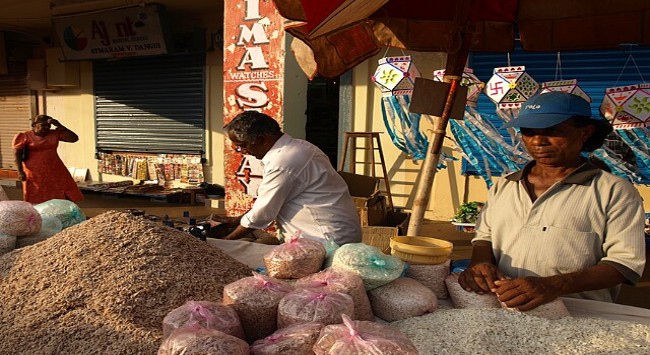India’s Rice Export Restrictions:
South Asian Import Issues
Puspa Sharma, Swadhi Karthikeyan
31 July 2024Summary
India has introduced restrictions on rice exports for a variety of reasons. This has impacted many countries in South Asia, where rice is a staple, and which imports rice mainly from India. In the context of the factors cited for the imposition of the restrictions, the future of rice exports from India looks bleak. However, this can be addressed through effective cooperation among the South Asian countries.
Introduction
Rice forms a staple in the South Asian diet, making it the most widely consumed cereal in the region. According to the Food and Agriculture Organization of the United Nations (FAO), rice accounts for 40-67 per cent of the total calorie intake in South Asia.[1]
India, as the largest producer of rice globally, is also the largest rice exporter. India’s exports of rice to the world in 2023 were nearly 18 million metric tonnes (MT), which was more than double the exports of the second-largest exporter, Thailand. In value terms, India’s global rice exports were about US$10.46 million (S$14.04 million) in 2023.[2] Forty-two countries depend on India for more than 50 per cent of their total rice imports.[3] Many South Asian countries also depend primarily on India for their rice imports.
The South Asian countries’ heavy reliance on rice imports from India makes them vulnerable to disruptions in India’s rice exports. The restrictions on rice exports that India has been imposing in phases since 2021, including the imposition of export duties, have hugely impacted rice availability and prices around the world, including in South Asia.
The South Asia region is particularly vulnerable to food security, given a high number of poor people living in the region, socio-economic disparities, high population density and climate change impacts, among other factors. According to the FAO, nearly 21 per cent of South Asia’s population is severely food insecure, and food security is low in around 40.6 per cent of the total population.[4] Climate-sensitive countries such as Bangladesh, Sri Lanka, Nepal and the Maldives are particularly vulnerable, given their geographical location. An export ban on the most essential food grain of the region leads to dramatic price and supply shocks, further exacerbating their food insecurity.
India’s measures to curb its rice exports have been for several reasons, including stabilising domestic rice prices, managing rice stockpiles for domestic food security, and concerns surrounding the impact of climate change on rice production, among others.[5] India might have a legitimate concern regarding its domestic food security, but its export restrictions have reduced trust and the spirit of cooperation in the region. This paper further dissects the reasons and implications of India’s restrictions on rice exports. It also discusses the future outlook and possible ways forward.
Restrictions in Rice Exports
Rice export restrictions are not new to India. In 2008, India imposed a ban on its rice exports in response to the global food crisis that had caused soaring food prices and heightened concerns over domestic food security. It partially lifted the ban in 2011 for certain types of rice, including non-basmati varieties, due to improved domestic stock levels. Again, at different times in 2022 and 2023, India undertook different measures such as the imposition of a 20-per cent export duty and a complete ban on certain types of rice as domestic prices rose and production concerns emerged, largely linked to adverse weather conditions.[6]
As of 2024, the ban on non-basmati white rice remains in place, with the government continuously monitoring the situation and considering potential adjustments based on domestic production and food security needs. The reasons cited for these export restrictions have been domestic food security concerns, climate change and its impact on rice yield due to monsoon variability and droughts, and price stability due to global conflicts, domestic politics, and power dynamics.[7]
Climate Change and its impact on Agriculture
Climate change has a pronounced impact on agricultural yield. Rising temperatures, heavy precipitation, increased frequency of droughts, heatwaves and intense tropical cyclones have been significant in India over the past few years. This has a direct impact on agricultural yield and production. A study has found that climate change and weather-related events will significantly affect rice production in India.[8] Over the past two decades, agricultural losses in India have increased tremendously in both frequency and magnitude[9] due to climate-related hazards and weather-related pests and diseases.[10] Future increases in temperature and alterations in the frequency and distribution of rainfall are anticipated to impact crop production and productivity across different regions and time periods.[11]
The Indian government has stated that the current rice export restrictions have been introduced in response to the dry conditions ensued by El Niño.[12] The impact of El Niño on rice production has been seen throughout Asia and is a global concern. Historically, during El Niño events, rice production has taken a dip (Figure 1). The drop in rice production due to these adverse weather conditions leads to a tighter supply in the global market, which results in higher prices of rice exports. Such price spikes can have significant implications for global food security, especially in regions heavily dependent on rice as a staple food.
Figure 1: Impact of El Nino on rice production

Source: “Global rice markets face stresses from El Nino, India Export Restrictions”, IFPRI Blog: Issue Post Markets, Trade and Institutions, 2 October 2023, https://www.ifpri.org/blog/global-rice-markets-face-stresses-el-nino-india-export-restrictions/.
The decision by the Indian government to impose rice export restrictions due to extreme climate events raises an important question. It is almost certain that climatic conditions are set to get worse and more frequent over time. Then, is India going to impose rice export restriction measures repeatedly and frequently in the future? If the anticipation of future climate crises likely influenced India’s recent decision to implement the export ban and related measures, there is every possibility that these kinds of measures will be implemented in the future too. This would eventually result in prolonged rice shortages and increased prices, further exacerbating food insecurity in the South Asian countries reliant on India for their rice supply.
Stockpile Management
The Indian government’s concerns about the possible reduction in rice stocks due to reduced production, and, hence, the need to maintain the national stockpile was stated as a reason for the imposition of the rice export restrictions. With the rise in the domestic prices of rice in 2023, India was concerned about domestic food security, which led to the release of nearly 2.5 million MT of rice from its government stockpile.[13] India’s rice stocks were the lowest in 2023, compared to the last five years.[14]
While concerns related to the maintenance of the national stockpile of rice has been stated as a reason for the rice export ban by India, it has been reported that India has more than adequate rice reserves.[15] While the stockpile level has seen fluctuations in the past few years, India currently has a rice stock of around 53 million MT, which is four times the buffer requirement of 13.5 million MT. Officials state that this has led to concerns over growing stocks and associated issues with maintenance and storage.[16] Maintaining the rice stockpile should not be an issue is also corroborated by the fact that the output of summer rice has increased over the years in India (Figure 2).
A recent study has also found that there is nearly 75 million MT of unexplained cereal gap in India’s reported data.[17] Therefore, instead of resorting to export restrictions with concerns of dwindling domestic supply and its impact on rice prices, it might be more appropriate to find the causes of the cereal gap and address the issues therein. Recently, as rice stocks surged by 14.5 per cent, there are reports that India might relax the export restrictions.[18] There are also reports that the Indian authorities are considering scrapping the 20-per cent tax on parboiled rice export.[19]
Figure 2: India’s summer rice output
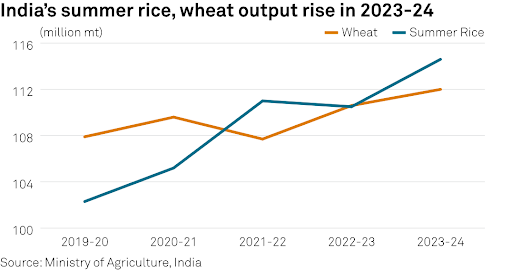
Source: INDIA ELECTIONS: Restrictive steps for wheat, rice exports may persist amid sticky inflation, SP Global, 7 May 2024, https://www.spglobal.com/commodityinsights/en/market-insights/latest-news/agriculture/050724-india-elections-restrictive-steps-for-wheat-rice-exports-may-persist-amid-sticky-inflation.
Domestic Politics
Domestic politics is an important factor for the rice export restrictions placed by India. Prioritising domestic availability of rice and ensuring price stability has been a leading cause of rice export restrictions as discussed above. Every government is mandated to do this, and hence, there is nothing wrong in this priority. During the election season, this becomes even more visible, as was the case in India. However, in an agricultural country like India where a majority of the population are farmers, there is also a flipside to restricting exports for domestic price stability.
Many Indian farmers were not happy with the export restrictions as they felt that the restrictions made them worse off. According to the National President of the Kisan Mahapanchayat (Farmers Union), the government policy to ban food exports and allow cheaper imports reduced farmers’ meagre agricultural incomes.[20] Moreover, despite the export restrictions, domestic food prices did not stabilise (Figure 3). India’s food inflation reached an all-time high of 190.6 points, which was up by 7.68 per cent compared to the previous year.[21] This had a double impact on a majority of the farmers who lost their income on the one hand, and as consumers, they had to face high food prices.
Figure 3: India’s food price inflation
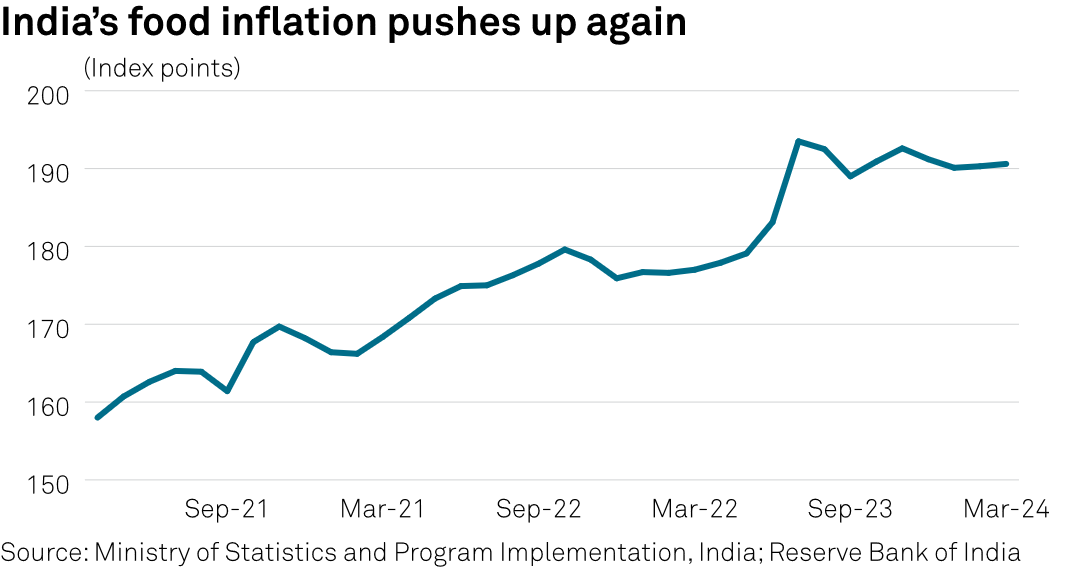
Source: INDIA ELECTIONS: Restrictive steps for wheat, rice exports may persist amid sticky inflation, SP Global, 7 May 2024., https://www.spglobal.com/commodityinsights/en/market-insights/latest-news/ agriculture/050724-india-elections-restrictive-steps-for-wheat-rice-exports-may-persist-amid-sticky-inflation.
Hence, justifying the rice export restriction policy as a preference towards domestic price stability and peace is perhaps a specious argument. The rising inflation and farmers’ discontent that was seen in the 2024 election results are evidence for that.
While the export bans appear to have not met domestic objectives, they had an impact on Indian rice-importing countries. The neighbouring South Asian countries, where a majority of the population consumes non-basmati rice as in India, were severely hit by the export restrictions.
South Asia’s Dependence on Indian Rice Imports
Almost 100 per cent of Nepal and Bhutan’s rice imports come from India, making them heavily reliant on one country/source to meet their shortfall and ensure domestic food security. Other South Asian countries are also heavily dependent on India for their rice imports (Figure 4). While the import share of Nepal, Bhutan and the Maldives have remained unchanged between 2021 and 2023, there was significant drop in the import share of Bangladesh in 2022 and 2023, and Sri Lanka in 2023.
The drop is attributed to India’s export restrictions and these countries’ turn towards other rice exporters such as Thailand. Countries that did not experience reductions in the import shares saw increases in rice prices due to the slapping of export duty on rice by India.
Figure 4: Share of India’s rice import in the South Asian countries
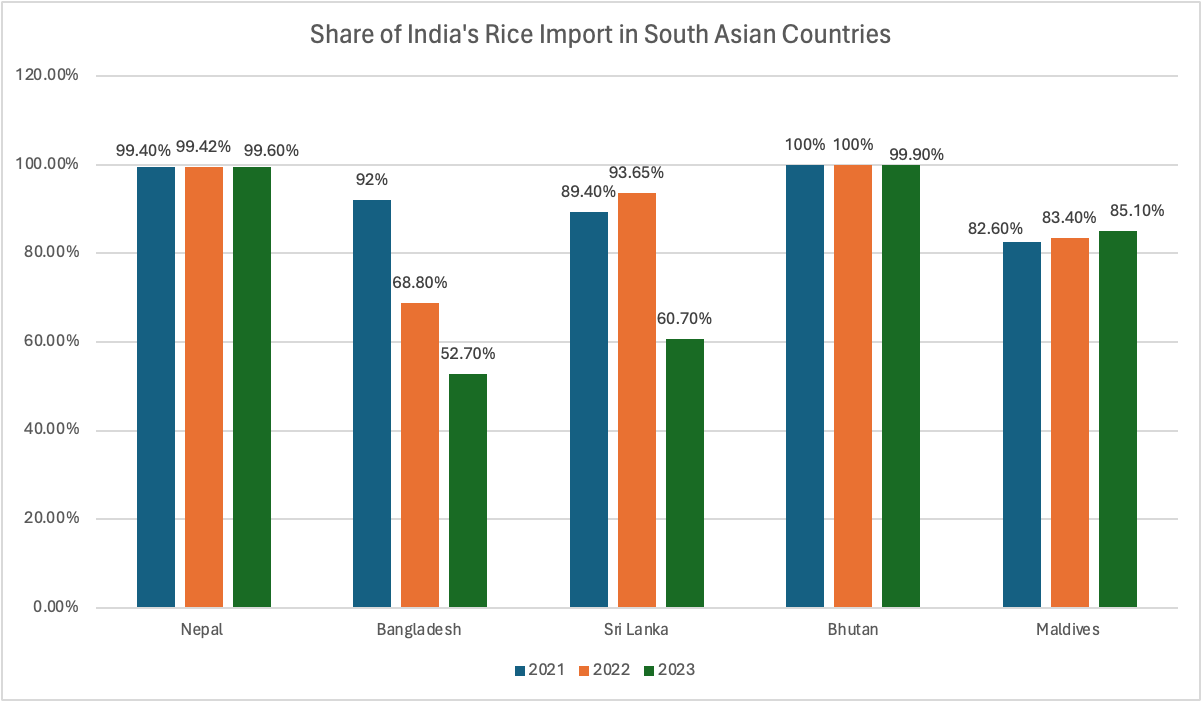
Note: Mirror data used.
Source: Calculations based on ITC trade map data. ITC Trade Map Dataset – Rice Import Statistics, Trade Statistics for International Business Development, https://www.trademap.org/Index.aspx.
India’s export price of rice is lower than that of other major rice exporters (Figure 5).[22] Consumers’ choices of rice varieties are also similar in South Asian countries. Moreover, abruptly switching to another export country is not easy. These are some of the factors that, despite the introduction of export duty by India on its rice exports, India’s share in rice imports of many South Asian countries did not fall. This marks the importance of India’s rice exports to these South Asian countries.
Figure 5: Rice export prices of the major exporters
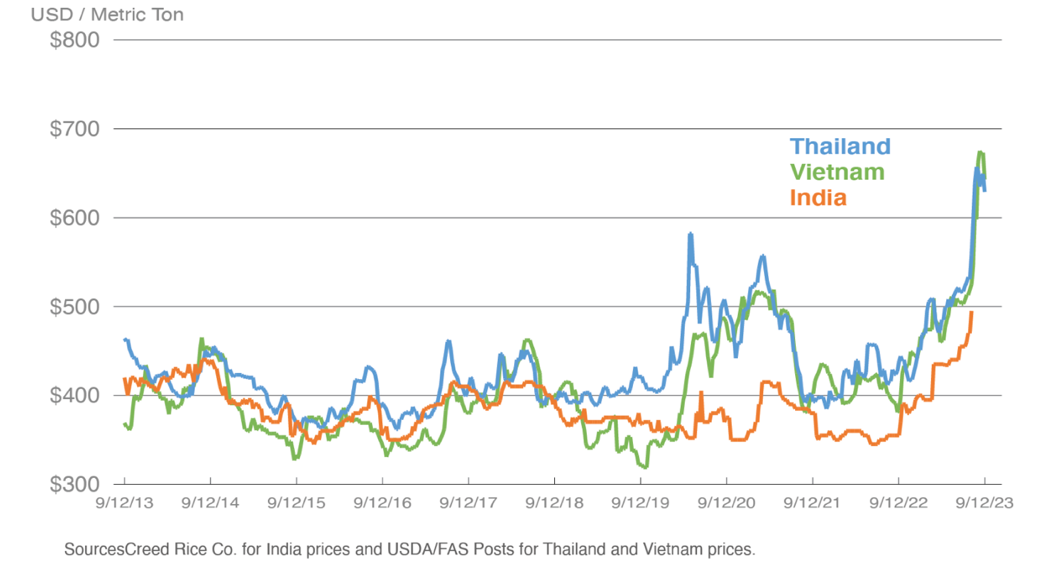
Source: Rice export prices highest in more than a decade as India Restricts Trade, US Department of Agriculture PSD Database, 19 September 2023, https://fas.usda.gov/data/rice-export-prices-highest-more-decade-india-restricts-trade.
Impact of India’s Rice Export Restrictions on the South Asian Countries
Restrictions on rice exports by India has led to a significant price volatility across the region. While India has tried to maintain a relatively stable supply of rice to major partners in South Asian countries, rice prices have hit a record high due to India’s imposition of export duty on its rice exports. The price hikes have disproportionately affected low-income households who spend a larger share of their income on food.
The export restrictions have also impacted rice millers in Nepal. Most rice mills in Nepal source paddy from India since Nepal’s paddy production alone is not sufficient to meet the requirements. According to Nepali rice millers, India’s periodic restrictions of paddy exports have drastically impacted domestic rice production in Nepal, causing the rice industry to be on the brink of collapse.[23]
Given South Asia’s fragile food security, restrictions in rice exports is likely to further worsen the situation. Due to most South Asian countries’ heavy reliance on Indian rice imports, supply disruptions and price hikes could lead to increased food insecurity in the region.
Conclusion
According to the International Food Policy Research Institute, the continuation of India’s export restrictions of rice will likely result in high prices and place further pressure on food security of Indian rice importing countries.[24] In view of the factors that have been the reasons for the imposition of restrictions on rice exports by India, it is possible that these kinds of restrictions will continue in the future.
The disruptions caused by climate change on agricultural production are cited as a factor for the restrictions. In the business-as-usual scenario, climate change and its disruptions will not only continue but will likely worsen in the future. This will impact rice production, and, hence, exports. The cascading effects of these will probably be seen in the form of rice price increases and volatility.
Also, domestic politics is here to stay. In the context of the nationalistic fervour that has gripped several nations across the globe, the countries’ food policies might be more inward-looking. Therefore, the future outlook of rice importing countries looks grim unless effective measures are taken on time.
It is in India’s interests to win the trust and confidence of its South Asian neighbours. Taking the lead for regional cooperation on crucial issues, with agriculture being one, is important. It is necessary to focus on research and development for climate-smart, sustainable agriculture, and adopt relevant technologies to lessen the impacts of climate change on agriculture, including rice yields. Sharing the results of such research and development, and technologies, among South Asian countries will go a long way.
India also needs to take a cautious approach towards export restrictions to the South Asian countries. Taking unilateral decisions is not the best approach. Regular dialogues and discussions on possible alternative measures can help manage the crisis.
As discussed above, even with the rice export restrictions, India has not been able to meet its domestic objectives. The restrictions have been placed in the interest of the consumers, but it has affected the farmers. It appears that export restrictions are not the best instrument even for domestic political reasons. These measures only lead to market distortions and can strain diplomatic relations.
Rice importing South Asian countries also need to rethink their food security strategies. They need to strengthen their agriculture sector and not rely too much on imports. It is also imperative for them to explore options for the diversification of their import sources.
. . . . .
Dr Puspa Sharma is a Visiting Senior Research Fellow at the Institute of South Asian Studies (ISAS), an autonomous research institute at the National University of Singapore (NUS). He can be contacted at puspa.sh@nus.edu.sg. Ms Swadhi Karthikeyan is a Research Intern at the same institute. She can be contacted at swadhi.karthikeyan@u.nus.edu. The authors bear full responsibility for the facts cited and opinions expressed in this paper.
[1] Joseph Glauber and Abdullah Mamun, “India’s new ban on rice exports: Potential threats to global supply, prices, and food security”, IFPRI Blog: Issue Post Markets, Trade and Institutions, 25 July 2023, https://www.ifpri.org/blog/indias-new-ban-rice-exports-potential-threats-global-supply-prices-and-food-security/#:~:text=Forty%20two%20countries%20get%20more,exceeded%2080%25%20for%20several%20countries.
[2] ITC Trade Map Dataset – Rice Import Statistics, Trade Statistics for International Business Development, https://www.trademap.org/Index.aspx.
[3] Ibid.
[4] UNFAO, “Food Security and Nutrition Around the World” in Asia and The Pacific- Regional Overview of Food Security and Nutrition 2022: Statistics and Trends, Food and Agriculture Organization of the United Nations. https://openknowledge.fao.org/server/api/core/bitstreams/6ca1510c-9341-4d6a-b285-5f5e8743cc46/content/sofi-2022/food-security-nutrition-indicators.html.
[5] Ibid.
[6] Joseph Glauber and Abdullah Mamun, “Global rice markets face stresses from El Nino, India Export Restrictions”, IFPRI Blog: Issue Post Markets, Trade and Institutions, 2 October 2023, https://www.ifpri.org/blog/global-rice-markets-face-stresses-el-nino-india-export-restrictions/.
[7] Suparna Sharma, “How India’s ban on some rice exports is ricocheting around the world”, Al Jazeera, 16 August 2023, https://www.aljazeera.com/economy/2023/8/16/how-indias-ban-on-some-rice-exports-is-ricocheting-around-the-world.
[8] Kuppannan Palanisami, KR Kakumanu , U S Nagothu, CR Ranganathan and S Senthilnathan, “Climate Change and India’s Future Rice Production: Evidence from 13 Major Rice Growing States of India”, SCIFED Journal of Global Warming, November 2017.
[9] Srivasta R K, R K Panda, and Arun Chakraborty, “Assessment of climate change impact on maize yield and yield attributes under different climate change scenarios in eastern India”, Ecological Indicators 120, 2021.
[10] Soora, Naresh Kumar, P K Aggarwal, Rani Saxena , Swaroopa Rani , Surabhi Jain, and Nitin Chauhan, “An assessment of regional vulnerability of rice to climate change in India”, Climatic Change 118, (2013): 638-699.
[11] Singh, Jyoti , Sandeep Sahany , K K Singh , Alan Robock, and Lili Xia. 2024. “Future Climate Change Impacts on Rice in Uttar Pradesh, India’s Most Populous Agrarian State”, Earth’s Future 12 (5).
[12] El Niño is a climate phenomenon characterised by the warming of the central and eastern tropical Pacific Ocean that can significantly impact global weather patterns.
[13] Arvin Donely, “India releases wheat and rice from reserves”, World Grain, 8 October 2023, https://www.world-grain.com/articles/18886-india-releases-wheat-and-rice-from-reserves.
[14] Pavithra K M, “ Data: FCI’s Central Pool Stocks of Rice & Wheat though above the Minimum levels are lower than Previous years”, 25 August 2023, https://factly.in/data-fcis-central-pool-stocks-of-rice-wheat-though-above-the-minimum-levels-are-lower-than-previous-years/.
[15] Dipak K Dash, “With 534 lakh tonnes, FCI rice stocks now at 4 times buffer requirement”, Times of India, 3 May 2024, https://timesofindia.indiatimes.com/india/with-534-lakh-tonnes-fci-rice-stocks-now-at-4-times-buffer-requirement/articleshow/109800013.cms.
[16] Ibid.
[17] Jean Dreze and Christian Oldiges, “Cereal Guzzler in the India Economy: 100 Million Tonnes of Grain ‘Missing’”, The Wire, 28 June 2024, https://thewire.in/economy/cereal-guzzler-in-the-indian-economy-100-million-tonnes-of-grain-missing.
[18] A Ksheerasagar, “3 rice stocks surge up to 14.5% on reports of India considering easing rice export limits”, Live Mint, 9 July 2024, https://www.livemint.com/market/stock-market-news/3-rice-stocks-surge-up-to-14-5-on-reports-of-india-considering-easing-rice-export-limits-stock-market-lt-foods-krbl-11720497146723.html.
[19] Pratik Parija and Shruti Shrivastava, “India Mulls Easing Rice Export Limits, Aiding World Buyers”, Bloomberg, 8 July 2024, https://www.bloomberg.com/news/articles/2024-07-08/india-mulls-easing-rice-export-limits-in-boon-to-world-buyers.
[20] Rajendra Jadhav and Mayank Bhardwaj, “After electoral setback, Modi may be forced to amend India’s food policy”, Reuters, 21 June 2024, https://www.reuters.com/world/india/after-electoral-setback-modi-may-be-forced-amend-indias-food-policy-2024-06-21/.
[21] Sampad Nandy, Aditya Kondalamahanty and Samyak Pandey, “INDIA ELECTIONS: Restrictive steps for wheat, rice exports may persist amid sticky inflation”, SP Global, 7 May 2024, https://www.spglobal.com/commodityinsights/en/market-insights/latest-news/agriculture/050724-india-elections-restrictive-steps-for-wheat-rice-exports-may-persist-amid-sticky-inflation.
[22] USDA, Rice Export Prices Highest in More Than a Decade as India Restricts Trade, Foreign Agricultural Service – US Department of Agriculture, 2023.
[23] Om Prakash Khanal, “India’s Policy on Rice Exports Adversely Affecting Domestic Rice Industry of Nepal”, New Business Age, 1 June 2024 https://www.newbusinessage.com/Articles/view/21404.
[24] Joseph Glauber and Abdullah Mamun, “India’s export restrictions on rice continue to disrupt global markets, supplies, and prices”, IFPRI Blog, 7 February 2024, https://www.ifpri.org/blog/indias-export-restrictions-rice-continue-disrupt-global-markets-supplies-and-prices/.
Pic Credit: Wikimedia Commons
-
 More From :
More From :
-
 Tags :
Tags :
-
 Download PDF
Download PDF


